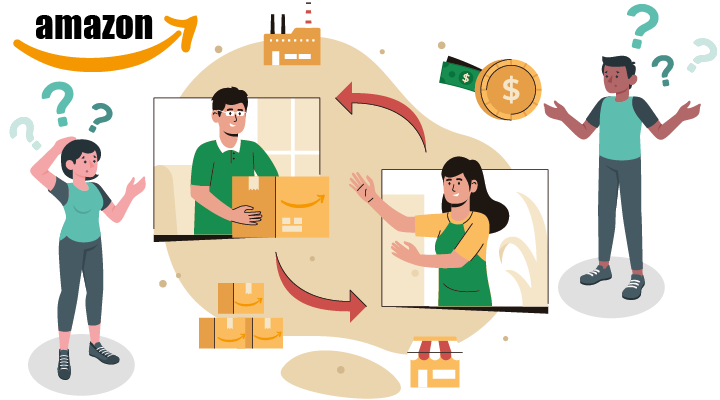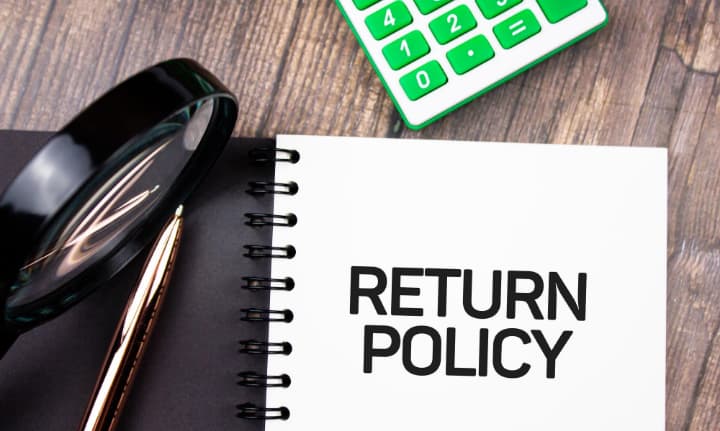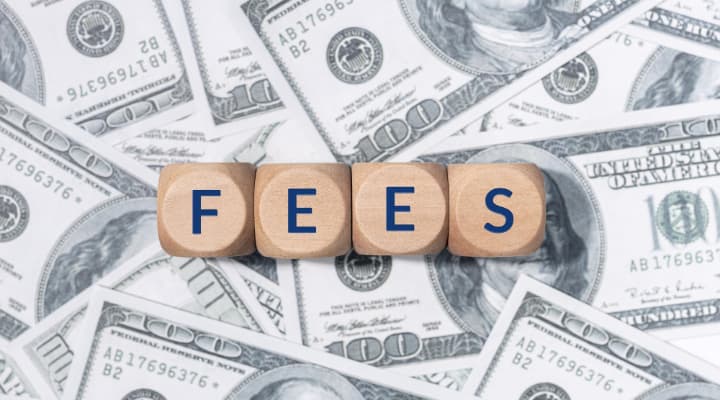
How Much is Amazon Restocking Fee?
Amazon restocking fees can vary based on
- Return reason
- Type of product
- Item’s condition
Generally, the restock fee is between 0% and 80% of the item price.
| Product | Customer Refund % |
|---|---|
| Products in original condition after the return period | 80% |
| CDs, DVDs, VHS tapes, cassette tapes, or vinyl records are removed from their original packaging | 50% |
| Product with damage, missing parts, not in original condition, or that have signs of use for reasons not due to an Amazon.com or seller error | Up to 50% |
| Open software or video games for reasons not due to an Amazon.com or seller error | 0% |
If a product comes back in its original, unopened packaging, the fee could be on the lower end of the scale.
Conversely, items missing parts or requiring repackaging may attract a higher percentage.
Here are some typical examples of when you might charge restocking fees as an Amazon seller:
- Return reason: The buyer changed their mind about the purchase, or the product didn’t meet their expectations.
- Product type: Products with shorter shelf life or items requiring strict sanitation measures might have higher restocking fees.
- Condition of returned item: Items returned damaged, missing parts, or requiring cleaning will likely result in a higher restocking fee.
What is Amazon Restocking Fee?
Amazon restocking fee is a charge applied when a customer returns a product. Amazon allows sellers to charge this fee under certain circumstances, which acts as a partial refund for the seller. When processing a return, the restocking fee is deducted from the customer’s refund, compensating the seller for any costs associated with restocking the item.
Retailers faced an approximate loss of $816 billion due to returns in 2022.
The restocking fee helps cover sellers’ costs when an item is returned, such as repackaging or quality inspection, ensuring sellers can continue providing various products to customers.
In 2019, online returns were estimated to account for 25% of total purchased items, costing $207 billion.
For example, a restocking fee might be applied if a customer changes their mind after completing an order and returns the item in perfect condition within the allotted 30-day return window. In cases of late returns or returns with damaged packaging, the fee is usually 20% – 50%.
Amazon Restocking Fees Return Period Breakdown
| Product Category | Return Period |
|---|---|
| Amazon Alexa Voice Shopping (Non-digital products) | Refer to Returns Center |
| Amazon Bulk Liquidations Store | Not eligible for return |
| Amazon Devices | 30 days |
| Amazon Fresh and Grocery Items | Not returnable (May be refunded or replaced) |
| Amazon Handmade | Refer to A-to-z Guarantee policies |
| Amazon Photos | Not returnable (May be refunded or replaced) |
| Amazon Pharmacy | Unable to accept returns |
| Amazon Renewed | 90 days (1 year for Renewed Premium products) |
| Amazon Warehouse | 30 days (90 days for Renewed items) |
| Automotive Items | Life of the published warranty |
| Baby Items | 90 days (365 days for gifts from Baby Registry) |
| Birthday Gift List | 90 days (30 days if purchased by registry owner) |
| Clothing and Accessories | 30 days |
| Collectibles (sports & entertainment) | Dependent on value and documentation |
| Collectible Coins | 30 days postmarked |
| Computers and Electronics | 30 days (15 days for Apple Brand products) |
| Custom Gift List | 90 days (30 days if purchased by registry owner) |
| Customized Products | Not returnable (May be refunded or replaced if damaged/defective) |
| Digital Products | Varies by type (e.g., 7 days for accidentally purchased Kindle books) |
| Fine Art | Dependent on value and documentation |
| Furniture | 30 days |
| Gift Cards | Not returnable (except as required by law) |
| Hazardous Materials | Not returnable |
| Jewelry and Watches | Returnable if within guidelines |
| Live Plants or Insects | Not returnable (but may be refundable) |
| Luxury Stores | 30 days |
| Major Appliances | 30 days |
| Mattresses | 100 days |
| Pet Food | Not returnable (but may be refundable) |
| Pre-Paid Phone or Game Cards | Not returnable |
| Software and Video Games | 30 days |
| Televisions | 30 days |
| Tickets | Not returnable |
| Unconditional Satisfaction Guarantee | Returnable if not satisfied |
| Wedding Registry Items | 180 days for gifts, 30 days for items purchased by registry owner |
| Wickedly Prime, Amazon Elements, Happy Belly, Mama Bear, and Presto! | 365 days |
Amazon lists items that cannot be returned, which you should review before initiating a return request.
By charging a restocking fee, Amazon aims to protect sellers from losses due to unnecessary returns while allowing customers to return items when needed.
Understanding the Amazon Return Policy

Amazon generally allows returns within 30 days of delivery for most items. However, there are exceptions to this rule. For example, Apple Brand products have a shorter return window of 15 days.
When customers return items in perfect condition within the allotted return period, Amazon sellers might withhold a range from 20% to 100 as a restocking fee for late returns.
Here are some factors that may affect the restock fee:
- Type of item: Different items may have varying restocking fees based on their specific category or condition. For instance, electronics might attract a restocking fee between 20% and 50% of the item price, while other categories could see a different range.
- Condition upon return: If an item is not returned in its original condition, the seller might deduct a higher restocking fee from the refund. This could range up to 50% or, in extreme cases, a 100% restocking fee.
- Return window: Returning items within the given window can help to minimize restocking fees. Late returns might incur additional charges, potentially up to 50% of the original product price.
- Seller’s discretion: Amazon allows sellers some discretion in setting restocking fees. However, these typically range from 20% to 100% based on the item’s condition and return timing.
- Amazon’s guidelines: The Amazon restocking fee is charged based on the original price of an item, following Amazon’s guidelines for fair and transparent practices.
- Category-specific fees: Some categories on Amazon may have specific restocking fees. For example, the restock fee for clothing might differ from that of electronic gadgets.
- 20% restocking standard: A 20% restocking fee is common for items returned past the return window but still in good condition.
- Handling of defective items: Amazon restocking fees generally do not apply to defective items, or those returned due to an error on Amazon’s part.
- Impact on refunds: The Amazon restocking fee directly impacts the customer’s refund. Customers need to be aware of these potential fees.
- Frequency of returns: Frequent returns might lead to higher restocking fees, as Amazon aims to discourage excessive returns.
- Educating customers: Sellers are encouraged to inform their customers about potential restocking fees, which can range between 20% and 50% of the original product price.
- Transparency in listing: Sellers should clearly state the potential for an Amazon restocking fee in their product listings to maintain transparency.
- Restock fee caps: While fees range up to 100%, most Amazon restocking fees are capped at a certain percentage to protect customer interests.
- Fee adjustments: Amazon may adjust restocking fees based on customer feedback and market trends.
- Restocking fee waivers: In certain scenarios, Amazon may waive the restocking fee, especially if the return is due to a fault on the seller’s or Amazon’s part.
By accurately advertising product details and conditions, sellers can reduce the likelihood of returns.
Factors Influencing Amazon Restocking Fee

Amazon Restocking Fees Condition of the Item
A higher Amazon restocking fee may apply if an item is returned with defects, damaged, or showing signs of use. Sellers must evaluate the product’s condition for an appropriate Amazon restocking fee.
The Type of Product Being Returned
Different products may have varying restocking fees depending on their nature. For instance, electronics might incur higher fees than clothing items due to the complexity and sensitivity of the devices.
The Late Return
Amazon typically allows customers a return window of 30 days to return a product. Beyond this period and in perfect condition, the seller may withhold a range from 20% to 100% of the item’s price as an Amazon restocking fee.
Partial and Full Refunds
A full refund is typically issued when an item is defective, damaged, or incorrect. Amazon’s policy states that you have 30 days from the date of delivery to return such items for free and receive a full refund.
A partial refund may apply in cases where the item is returned due to the buyer’s preference or if its condition has been altered. Amazon allows sellers to charge the restock fee ranging from 20% to 50%. This restocking fee was deducted from the refund amount.
Some states in the U.S.A., such as Connecticut, Maryland, Nevada, Pennsylvania, Virginia, West Virginia, and Wisconsin, may apply taxes to restocking fees, and these costs can affect your refund amount and the source.
To check the return window and learn more about Amazon’s return policy, visit the Your Orders page and select “Return or Replace Items.”
Dealing with Amazon Restocking Fees Disputes
Upon receiving a claim for a return request, evaluate the product’s condition and check if it meets the Amazon restocking fees guidelines.
- You cannot charge a restocking fee if the product is unopened and in mint condition.
- For items returned in worse condition than when dispatched, you may charge of up to 50% as a restocking fee.
- For damaged products, you can charge a restocking fee of 20%.
Amazon Restocking Fee from Buyers
If a buyer believes Amazon’s restock fee is unfair or incorrect. They could communicate with the seller through Amazon’s messaging platform with relevant photos or documents supporting their claim.
Amazon Restocking Fee from Seller’s point of view
If the seller provides no satisfactory resolution, escalate the dispute to Amazon Customer Service. Amazon mediates disputes and makes the final decision.
Amazon Seller’s Perspective
Be aware of the different Amazon FBA fees to ensure you stay competitive. It would help if you calculated your profit margin accurately, considering these fees alongside your seller restocking fees.
Amazon Restocking Fee Considerations
There are a few considerations that affect the seller restocking fee:
- State laws may limit the restocking fee percentage you can charge.
- The product category might affect the restock fee charged.
Amazon Restocking Fees Tips
Here are some tips for effectively managing restocking fees and returns:
- Keep track of the reasons for returns: Analyze the reasons for returns to identify any trends or problematic products that could be addressed.
- Ensure your return policy is explicit and easy to understand, minimizing confusion and potential customer disputes.
- Promptly and professionally handle return requests, positively impacting your seller’s reputation.
Leveraging the Marketgap FBA Calculator for Accurate Profit Margins
To aid in this complex calculation of profit margins, considering both Amazon FBA fees and seller restocking fees, the Marketgap FBA calculator emerges as a valuable tool. This calculator is designed to provide Amazon sellers with a clear and detailed breakdown of the various fees associated with using Amazon’s FBA service. By inputting specific details about your products, such as dimensions, weight, and selling price, you can get an accurate estimate of the fees you’ll incur, helping you to price your products more effectively.
Also, try MarketGap’s FBA Fee Calculator as a browser extension right on any Amazon page. You can use it on any product page, search, or category.
The Role of Amazon Customer Service in Managing Restocking Fees
Understanding Amazon’s Restocking Fee Policies: A Guide by Customer Service
Amazon Customer Service is not just a point of contact for queries and issues; it plays a pivotal role in the ecosystem of Amazon’s e-commerce platform, especially when handling Amazon restocking fees. This team is instrumental in guiding buyers and sellers through the complexities of Amazon’s restocking fee policies, ensuring a smooth and fair transaction process.
Seller’s Handbook: Adhering to Amazon’s Restocking Fee Guidelines
For sellers, Amazon Customer Service provides a masterclass in understanding the niche-specific guidelines surrounding restocking fees. These guidelines are crucial for maintaining a consistent business model across the diverse range of products available on Amazon, from small electronic gadgets to large pallets of goods. By adhering to these guidelines, sellers can align their practices with Amazon’s best practices, ensuring they meet the expectations of a wide range of clients.
Buyer’s Guide: Navigating Restocking Fees with Amazon Customer Service
On the other hand, buyers benefit from the wealth of information and assistance Amazon Customer Service provides. Whether understanding the timeframe for returning an item or calculating the potential restock fee, the customer service team is equipped to answer frequently asked questions, aiding consumers in making informed decisions. This is particularly important in an online shopping environment where the clarity and transparency of return policies and associated costs influence consumer behavior.
The Role of Amazon Customer Service in the Chargeback Process
Moreover, Amazon Customer Service plays a crucial role in the chargeback process. When a dispute arises over a restocking fee, the customer service team will mediate and provide a resolution based on Amazon’s policies and available data. This helps maintain trust and fairness and ensures that the economics of the transaction are preserved, protecting the interests of both buyers and sellers.
Contacting Amazon Customer Service for Restocking Fee Inquiries
The process is straightforward for those needing to reach Amazon Customer Service regarding restocking fees. Customers can click here or email the team directly at cs-reply@amazon.com for prompt and detailed assistance. This accessibility is part of Amazon’s commitment to providing a seamless shopping experience, reinforcing its position as a leader among e-commerce platforms.
Legal Aspects of Amazon Restocking Fee
Between 20% and 50% of the Item Price: Complying with Amazon’s Legal Guidelines
When dealing with Amazon restocking fees, it’s crucial to understand the legal aspects. As an Amazon seller, your actions must comply with Amazon’s guidelines to avoid legal issues or penalties. Restocking fees are legally allowed (for example, a 50% charge) if properly disclosed. Charging the Amazon restocking fee allows sellers to recover potential losses while conforming to Amazon’s guidelines.
Restocking Fees Charged Based on the Original Price of an Item: Understanding the Return Window
The return window plays a vital role in determining the restock fee. Here are some factors to consider when charging a restocking fee on Amazon:
Amazon’s Guidelines on Restock Fees: Disclosure Requirements
Amazon’s guidelines require sellers to disclose restocking fees before initiating a charge. Restocking fees cannot be charged for items returned due to defects or missing parts.
A 100% Restocking Fee: Rare but Within Amazon’s Policy
The fee must be based on the item’s charge, not including the shipping charge. A 100% restocking fee can be charged. However, it’s rare and should comply with Amazon guidelines.
Frequently Asked Questions about Amazon Restocking Fees

How is the Amazon restocking fee calculated? Understanding the Chargeback Process
Amazon sellers can withhold a range from 20% to 100 as a restocking fee for late returns. The fee varies depending on the condition of the returned items, but it typically applies to items that are not defective or damaged.
What is the return policy on opened items? Exploring the Costs for Consumers
Items shipped from Amazon.com, including Amazon Warehouse, can be returned within 30 days of delivery, with some exceptions. However, the returned items must be in good condition to be accepted.
Why am I being charged an Amazon restocking fee?
Amazon restocking fee is charged when customers return items that are not defective or damaged. These fees help cover processing the return and restocking the item.
Does Amazon charge a return fee?
Yes, Amazon charges a 100 % restocking fee in certain circumstances. For example, if a customer changes their mind and returns a non-defective item.
How can I avoid the Amazon restocking fees? Tips and Best Practices
To avoid a restocking fee, ensure you:
- Double-check the product details and specs before purchasing
- Keep the item in its original condition
- Return the item within the specified time frame, which is usually 30 days

How do I set up an Amazon restocking fee? A Step-by-Step Guide for Retailers
If you are an Amazon seller and want to set up a restocking fee, follow these steps:
- Log in to your Amazon Seller Central account
- Navigate to Settings > Return Settings
- Edit your return settings to include the Amazon restocking fees as per Amazon’s guidelines
Why is Amazon charging for returns? Unpacking the Economics Behind the Policy
Amazon charges for returns, specifically through restocking fees, to compensate sellers for potential losses associated with processing and repackaging returned items, especially if they are not returned in their original condition.
Is there a penalty for Amazon returns? Understanding the Impact on Your Wallet
There isn’t a “penalty” per se for Amazon returns. However, restocking fees can apply under certain conditions, such as if an item is returned late, without original packaging, or shows signs of use. This fee is deducted from the refund amount.
Why is there a restocking fee? Exploring the Rationale Behind E-commerce Charges
A restocking fee is intended to cover the seller’s costs when an item is returned, such as repackaging, quality inspection, or re-listing. It is a deterrent to unnecessary returns and covers any potential loss in value of the returned product.
Additional Questions about Amazon Stocking Fees for Learning Best Practices

Is a 25% restocking fee normal? Understanding Standard E-commerce Practices and Consumer Expectations
A 25% restocking fee, part of the range of up to 50%, is within what Amazon sellers may charge based on the item’s condition and category. Whether it’s “normal” can vary based on the seller’s discretion and the specifics of the return situation. A 50% charge is possible.
What does a 10% restocking fee mean? Deciphering Retailer Chargeback Policies in Online Marketplaces
A 10% restocking fee, which falls significantly below the cap of up to 50%, means that if a product is returned, the seller will withhold 10% of the original purchase price from the refund to cover the charge associated with processing and repackaging the returned item.
How Much percentage is the Amazon Restocking Fees? Analyzing Amazon’s Pricing Strategy and Its Impact on Consumer Behavior
The Amazon restocking fee generally ranges between 20% and 50% of the original product price, depending on the return reason, type of product, and the item’s condition. A 50% charge is possible.
How long is the return period for Mattresses on Amazon? Navigating AmazonPrime’s Return Timeframes and Best Practices
The return period for mattresses on Amazon is 100 days.
How many days is the return period for Automotive Items on Amazon? Understanding Amazon’s Specific Policies for Niche Market Segments
The return period for Automotive Items on Amazon is for the life of the published warranty, with potential restocking fees of up to 50% based on the item’s condition.
How long is the return period for Baby Items? A Guide to Amazon’s Return Policies and Parental Consumer Behavior
The return period for Baby Items is 90 days (365 days for gifts from Baby Registry).
How many days is the return period for Computers and Electronics on Amazon? Exploring Amazon’s Electronics Return Timeframe and Its Economic Implications
The return period for Computers and Electronics on Amazon is 30 days (15 days for Apple Brand products).
How long is the return period for Digital Products? Mastering the Return Policies of Amazon and Other E-commerce Platforms
The return period for Digital Products on Amazon varies by type (e.g., 7 days for accidentally purchased Kindle books).
How much is the return period for Furniture on Amazon? Learning About Amazon’s Furniture Return Policies and Client Expectations
The return period for Furniture on Amazon is 30 days.
How long is the return period for Televisions? Unpacking Amazon’s Return Policy for Large Electronics and Its Impact on Prices and Investments
The return period for Televisions is 30 days.
Remember that it is crucial to be transparent about restocking fees and follow Amazon™’s policies to avoid negative feedback or A-to-Z claims.
Important Note: Transparency in Restocking Fees
Remember that it is crucial to be transparent about restocking fees, particularly when they range up to 50%, and follow Amazon’s policies to avoid negative feedback or A-to-Z claims.
Amazon Restocking Fee Full Table of Contents
- How Much is Amazon Restocking Fee?
- What is Amazon Restocking Fee?
- Factors Influencing Amazon Restocking Fee
- Partial and Full Refunds
- Dealing with Amazon Restocking Fees Disputes
- Amazon Seller’s Perspective
- The Role of Amazon Customer Service in Managing Restocking Fees
- Understanding Amazon’s Restocking Fee Policies: A Guide by Customer Service
- Seller’s Handbook: Adhering to Amazon’s Restocking Fee Guidelines
- Buyer’s Guide: Navigating Restocking Fees with Amazon Customer Service
- The Role of Amazon Customer Service in the Chargeback Process
- Contacting Amazon Customer Service for Restocking Fee Inquiries
- Legal Aspects of Amazon Restocking Fee
- Frequently Asked Questions about Amazon Restocking Fees
- How is the Amazon restocking fee calculated? Understanding the Chargeback Process
- What is the return policy on opened items? Exploring the Costs for Consumers
- Why am I being charged an Amazon restocking fee?
- Does Amazon charge a return fee?
- How can I avoid the Amazon restocking fees? Tips and Best Practices
- How do I set up an Amazon restocking fee? A Step-by-Step Guide for Retailers
- Why is Amazon charging for returns? Unpacking the Economics Behind the Policy
- Is there a penalty for Amazon returns? Understanding the Impact on Your Wallet
- Why is there a restocking fee? Exploring the Rationale Behind E-commerce Charges
- Additional Questions about Amazon Stocking Fees for Learning Best Practices
- Is a 25% restocking fee normal? Understanding Standard E-commerce Practices and Consumer Expectations
- What does a 10% restocking fee mean? Deciphering Retailer Chargeback Policies in Online Marketplaces
- How Much percentage is the Amazon Restocking Fees? Analyzing Amazon’s Pricing Strategy and Its Impact on Consumer Behavior
- How long is the return period for Mattresses on Amazon? Navigating AmazonPrime’s Return Timeframes and Best Practices
- How many days is the return period for Automotive Items on Amazon? Understanding Amazon’s Specific Policies for Niche Market Segments
- How long is the return period for Baby Items? A Guide to Amazon’s Return Policies and Parental Consumer Behavior
- How many days is the return period for Computers and Electronics on Amazon? Exploring Amazon’s Electronics Return Timeframe and Its Economic Implications
- How long is the return period for Digital Products? Mastering the Return Policies of Amazon and Other E-commerce Platforms
- How much is the return period for Furniture on Amazon? Learning About Amazon’s Furniture Return Policies and Client Expectations
- How long is the return period for Televisions? Unpacking Amazon’s Return Policy for Large Electronics and Its Impact on Prices and Investments
- Important Note: Transparency in Restocking Fees
Amazon Restocking Fee Conclusion
Denes, with 20 years experience in logistics, holds a Logistics Manager degree from Budapest’s Logistics Association and has penned a thesis on mobile devices. Venturing into e-commerce, Denes specializes in Fulfilled By Amazon and passionately educates others about Amazon selling techniques.